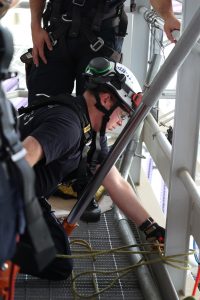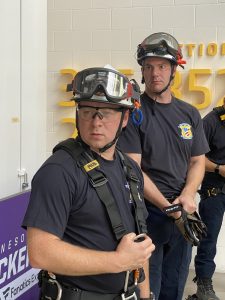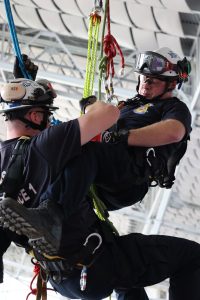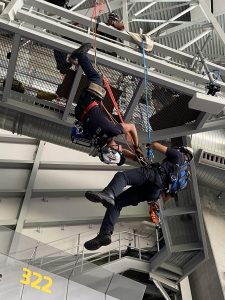Hennepin EMS supports advanced search and rescue operations
Paramedics Train to Rise to Any Challenge
On any given day, Jonathan Thomalla knows to expect the unexpected. As a paramedic with Hennepin Emergency Medical Services (HEMS), he responds to an endless array of scenarios ready to do whatever it takes to provide care and save lives. It could be a heart attack, an accident, or a mental health crisis. And in Jonathan’s case, it might mean he’s helping that patient while suspended from a rope, 100 feet in the air.
 Jonathan is part of a small group of paramedics specially trained in search and rescue techniques as part of Minnesota Task Force 1 (MNTF1), an Urban Search and Rescue program established after 9/11. MNTF1 includes representatives from Fire Departments in Minneapolis, St. Paul, Edina and Rochester and the Dakota County Special Operations Team. Jonathan is one of five paramedics now on the team.
Jonathan is part of a small group of paramedics specially trained in search and rescue techniques as part of Minnesota Task Force 1 (MNTF1), an Urban Search and Rescue program established after 9/11. MNTF1 includes representatives from Fire Departments in Minneapolis, St. Paul, Edina and Rochester and the Dakota County Special Operations Team. Jonathan is one of five paramedics now on the team.
MNTF1 trains for situations big and small, from a tornado or a bridge collapse to an “urban explorer” who gets injured climbing in an abandoned building and needs help.
That’s why, on a sunny autumn day, Jonathan found himself suspended from the rafters at US Bank Stadium, practicing techniques to help someone caught in a precarious situation. Jonathan climbed over the railing, lowered himself down and attached the “victim” to his rope so they could be lowered down to safety together. For Jonathan, the practice is challenging and exhilarating, knowing these skills can save lives.
“Much like many other emergency services, we train for the worst case scenario,” said Jonathan. “Unfortunately we don't know if or when that will happen, but we want to make sure that we're prepared for that so we can respond and help people in a timely and safe manner.”
HENNEPIN EMS SERVES
 Beyond the MNTF1 work, which is statewide, HEMS paramedics put their advanced training to use as Technical Rescue Medics (TRM) throughout their primary service area. That includes both urban and suburban communities that span 266 square miles, supporting a residential and business population of more than one million people. In addition to the city of Minneapolis, HEMS serves 14 communities from St. Anthony in the northeast to Tonka Bay south and west of Minneapolis. In recent years the TRM team has been called to assist patients within and outside the HEMS primary service area who were injured in incidents ranging from mudslides along the riverfront to construction accidents and building collapses.
Beyond the MNTF1 work, which is statewide, HEMS paramedics put their advanced training to use as Technical Rescue Medics (TRM) throughout their primary service area. That includes both urban and suburban communities that span 266 square miles, supporting a residential and business population of more than one million people. In addition to the city of Minneapolis, HEMS serves 14 communities from St. Anthony in the northeast to Tonka Bay south and west of Minneapolis. In recent years the TRM team has been called to assist patients within and outside the HEMS primary service area who were injured in incidents ranging from mudslides along the riverfront to construction accidents and building collapses.
For the paramedics, adding TRM responsibilities is a significant commitment, but it’s also another opportunity to advance their skills to serve the community.
“Our paramedics work here for a reason,” said Dr. Gregg Jones, emergency medicine physician at Hennepin Healthcare and an assistant medical director for HEMS. “They can go work at a slower agency where they have a lot more downtime to maybe read a book during the shift here and there. Our paramedics don't have that luxury. They go from call, to call, to call. I think that type of job attracts a certain type of person and a certain type of paramedic. And you take that already motivated, hard-working group and then you slice out a smaller section that wants to take it one step further and serve their community in another way. I think it speaks volumes for how dedicated they are as a team.”
ANY SITUATION, ANY TIME
MNTF1 training is based on the premise that team members need to be ready for anything.
“We're working in a lot of dangerous situations,” explained Kelly Munn, HEMS paramedic and MNTF1 team member. “If we have to go into a trench or a building that collapsed and someone's pinned in there, we are probably working on our bellies. We're doing a lot of reaching in confined spaces. We'd have no lighting except the light from our helmet. You need to stay calm or you lose the trust of everyone around you.”
 Preparing for the worst takes a lot of training, developing skills the team members hope they never have to use. There is intensive hands-on instruction around structural collapse, trench rescues, and high-angle rope rescuing, like the exercise at US Bank Stadium. Just getting on the task force requires hundreds of hours of training and the members go back regularly to practice and improve their skills.
Preparing for the worst takes a lot of training, developing skills the team members hope they never have to use. There is intensive hands-on instruction around structural collapse, trench rescues, and high-angle rope rescuing, like the exercise at US Bank Stadium. Just getting on the task force requires hundreds of hours of training and the members go back regularly to practice and improve their skills.
“These situations don't happen very often, but that's why we train so much,” said Angela Erikson, another HEMS paramedic and MNTF1 member. “When these kinds of events do happen, it's a huge thing and we want everybody to go home safe. We want to make good rescues.”
The paramedics often have to go in on their days off to participate in training exercises. The work is physically and mentally exhausting but they understand these skills need to become second nature, so they’re ready for the real thing.
“The fear is, if you send untrained people in, they increase the casualty number,” said Dr. Jones. “So our approach is slow and methodical but it's safe because of all this training we've had. We don't just rush into a burning building. We train on how to do that sort of stuff.”
MEDICAL EXPERTISE IN THE MIDDLE OF A CRISIS
Adding paramedics to MNTF1 brought new and important skills to the team to help patients in often desperate situations.
“We see a lot of different things on our normal call volume so we bring that experience to the team,” said Munn. “For example, when a person is in a structural collapse and they're trapped, it may take an hour or more to get them out. That's where it's important to have medical care come in. We might start an IV, check their airway, check their vital signs. We can try and figure out how long we have before this person becomes critical and we can take steps to prevent that from happening.”
Placing an IV or a breathing tube can be difficult enough during a “routine” call, but these task force members need to re-learn these skills in the most difficult circumstances.
 “If we place an IV, we might have to place it backwards because you're at the head of the patient and you can't get around the other side,” explained Dr. Jones. “Then when you go to secure that IV, because of the dust or the sweat, you might have to wrap tape all the way around just to keep the IV in place. Maybe you’re doing this in negative 40 degrees, so you need to package them up so they're as warm as you can get them. Then you have to get them onto some sort of patient movement device to get them out of whatever mess you're in, which can be difficult.”
“If we place an IV, we might have to place it backwards because you're at the head of the patient and you can't get around the other side,” explained Dr. Jones. “Then when you go to secure that IV, because of the dust or the sweat, you might have to wrap tape all the way around just to keep the IV in place. Maybe you’re doing this in negative 40 degrees, so you need to package them up so they're as warm as you can get them. Then you have to get them onto some sort of patient movement device to get them out of whatever mess you're in, which can be difficult.”
As with all their calls, the paramedics have to do this work with an air of calm, to keep the patient from panicking and to avoid mistakes.
“Having the education that they give us takes away a lot of the nerves, so you're not making errors because you have the knowledge to go into these scenarios,” said Erikson. “Being able to have that one successful rescue? It's worth it. All day long, it is worth it.”
PROTECTING THE HEALTH AND SAFETY OF THE TEAM
Tending to patients is only one part of the paramedics’ mission when they are called to a search and rescue scene. They also play a critical role caring for and protecting their fellow team members. If the rescuers get injured or sick it can derail efforts to find survivors.
“Everything from making sure that people are doing proper hand sanitizing before meals, to foot care, to making sure people have their daily medications,” said Dr. Jones. “The majority of prolonged deployments, you'll start your day or your shift with a visit with a medical specialist. They'll check vital signs and make sure that you are doing okay before they're going to put you out on a rubble pile or something like that, doing the search.”
Given the dangerous settings of some rescue efforts, injuries to team members are inevitable. The paramedics can quickly tend to those injuries to prevent things from getting worse, allowing the rescuers to continue their important work.
TRUST, COMMUNICATION AND TEAMWORK
While HEMS paramedics often work alongside firefighters and other emergency teams during their day-to-day shifts, the MNTF1 training takes this teamwork to new levels. This is vital as they are called into chaotic scenes and are asked to perform different roles working seamlessly together.
“When you're in a trench trying to rescue someone that's, say, trapped from their waist down, there's two almost competing teams working on it,” said Dr. Jones. “The rescue specialists are trying to dig the patient out of there. The medical specialists are trying to do patient care. Sometimes it's a dance. We have to communicate and advocate for patient care, but do so respectfully.”
 Quarterly training sessions and continuing education are the price that these paramedics pay to be a part of the team. At the same time, Dr. Jones said the paramedics who are attracted to these roles tend to be those who are energized by the challenge.
Quarterly training sessions and continuing education are the price that these paramedics pay to be a part of the team. At the same time, Dr. Jones said the paramedics who are attracted to these roles tend to be those who are energized by the challenge.
“It's never wrong to want the paramedics that serve your community to be better trained, more engaged, more excited about their job,” he said. “Having skill sets that, again, hopefully you don't need them to use for you, but they have, if you do. I think that's a super valuable thing that Hennepin EMS and our paramedics bring to the table.”
For Jonathan Thomalla, there’s no substitute for hands-on training, working with other Task Force Members to get comfortable with specialized equipment, and establishing relationships with people who may one day have your life in their hands.
“I find this interesting. I'm trying to pick up all the little tips and tricks,” he said. “For me, when I get to come and do these trainings, I consider it an honor and a privilege that I'm part of the state team and I try to take in as much information as I can.”
Working and learning side-by-side reinforces the trust that is necessary when there are many moving parts and every decision is critical.
“It helps to remember that we're on the same team here.” said Dr. Jones. “The rescue guys have a mission and we have a mission, but it's ultimately the same mission, right? To save this patient's life.”
SERVING THE METRO AREA AND BEYOND
MNTF1 was created as part of a federal grant, after the 9/11 attacks demonstrated the need to prepare for large scale search and rescue response. Since that time, while the full Task Force has not had to be mobilized, members have assisted with the 35W bridge collapse and other emergencies including flood rescue efforts around the region.
As much as they wish their skills were not needed, the paramedics say they appreciate having the ability to respond when the moment calls.
“I just love helping people,” said Erikson. “You are able to come to the aid of somebody on their worst day. Whatever's happening to them is terrible so we stay cool, calm, and collected. We have the education and the knowledge to deal with those things and to come up with a solution to these problems.”
Sometimes that dedication means spending a day high in the air, swinging from ropes and harnesses, figuring out how to help someone safely to the ground.
“I enjoy solving problems,” said Thomalla. “If somebody's sick or injured, we have to come up with a solution or if somebody's trapped somewhere, we have to come up with a solution. I enjoy figuring out how to help people.”
The paramedics know well enough that you can’t anticipate everything, but with the advanced training as part of MNTF1, they are equipped with the tools and expertise to rise to whatever challenges that may come their way.

